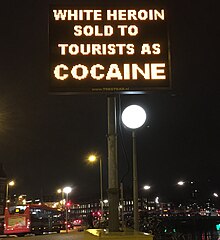Drug tourism is travel for the purpose of obtaining or using drugs for recreational or medicinal use that are unavailable or illegal in one's home jurisdiction. A drug tourist may cross a national border to obtain a drug that is not sold in one's home country over the counter, or to obtain an illegal drug that is more available in the visited destination. A drug tourist may also cross a sub-national border (from one province/county/state to another) in order to purchase alcohol or tobaccomore easily, or at a lower price.
Empirical studies show that drug tourism is heterogeneous and might involve either the pursuit of mere pleasure and escapism or a quest for profound and meaningful experiences through the consumption of drugs.
Drug tourism has many legal implications, and persons engaging in it sometimes risk prosecution for drug smuggling or other drug-related charges in their home jurisdictions or in the jurisdictions they are visiting, especially if they bring their purchases home rather than using them abroad. The act of traveling for the purpose of buying or using drugs is itself a criminal offense in some jurisdictions.
By country/region
Asia/Middle East
The Rif Mountains of Morocco are a well-known center for the production of hashish.
Europe

A sign of a cannabis coffee shop inAmsterdam
In Europe, the Netherlands, and especially the Dutch capital, Amsterdam, is a popular destination for drug tourists, due to the liberal attitude of the Dutch toward cannabis use and possession. Drug tourism thrives because legislation controlling the sale, possession, and use of drugs varies dramatically from one jurisdiction to another.
In May 2011 the Dutch government announced that tourists would to be banned from Dutch coffeeshops, starting in the southern provinces at the end of 2011,[1] and the rest of the country by 2012,[2] though this was never made into law and thus coffeeshops throughout the Netherlands continue remain open to tourists as of August 2014. On 25 November 2014 two British tourists aged 20 and 21 died in a hotel room in Amsterdam, after snortingwhite heroin that was sold as cocaine by a street dealer.[3] The bodies were found less than a month after another British tourist died in similar circumstances. At least 17 other people have had medical treatment after taking the white heroin.[4]
North America
Drug tourism from the United Statesoccurs in many contexts. Americans between the ages of 18 and 21 may cross the border into Canada or Mexicoto purchase alcohol. Conversely, many Canadians travel to the United States to purchase alcohol at lower prices due to high taxes levied on alcohol in Canada. Americans living in dry counties also frequently cross county or state lines to purchase alcohol.
Many Americans cross state lines to purchase cigarettes, crossing from a jurisdiction with very high cigarette taxes to a jurisdiction (such as another state or an Indian nation) with lower cigarette taxes. This occurs particularly in the Northeastern United States, where states levy among the highest tobacco taxes in the nation.
Since the legalization of marijuana inColorado and Washington state, many drug tourists from states and countries where cannabis is illegal travel to these states to purchase cannabis and cannabis products.
South America
In South America, some tourists are attracted to Amazonian villages to try a local liquid called ayahuasca which is a mixture of psychedelic plants that is used in traditional ceremonies. Similarly, tourists in Peru try hallucinogeniccactus called San Pedro which originally has been used by local tribes.
Oceania
In Australia, the Australian Capital Territory and South Australia have a more liberal approach to marijuana use, promoting interstate drug tourism, particularly from Victoria and New South Wales. In addition, some areas of northern New South Wales have a liberal recreational drug culture, particularly areas around Nimbin where the annualMardiGrass festival is held.
Continued....For Female Sex Tourism, please see:
Travel tips-Tell you about Extralegal Tourism-III


No comments:
Post a Comment